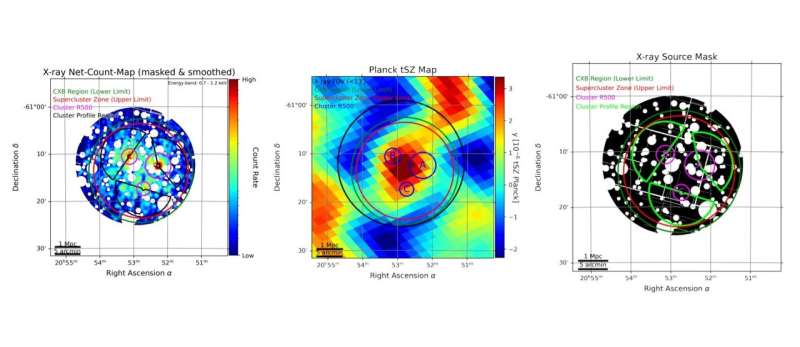July 26, 2021 report
French astronomers explore supercluster PLCK G334.8-38.0

Using ESA's XMM-Newton telescope, a team of French astronomers has conducted an X-ray study of a supercluster known as PLCK G334.8-38.0. Results of this research, published July 16 on the arXiv pre-print server, deliver important insights into the nature of this structure.
Containing structures with a range of masses, from massive and dense clusters of galaxies to low-density bridges, filaments and sheets of matter, superclusters are among the largest structures in the known universe. Finding and investigating superclusters in detail could be essential to improving our understanding of the formation and evolution of large cosmic filaments.
PLCK G334.8-38.0 is one of the two superclusters discovered a few years ago using ESA's Planck satellite. Given that it is a poorly studied triplet-cluster system, a group of astronomers led by Alexander Kolodzig of the Paris-Saclay University decided to perform an X-ray analysis of this object in order to shed more light on its properties.
"We want to use this XMM-Newton data in conjunction with Planck and optical data to conduct a comprehensive multiwavelength analysis in order to constrain the cluster members of the system and their dynamics, and the presence and the properties of WHIM [warm-hot intergalactic medium] around them. This work represents the first step in this comprehensive analysis," the researchers explained.
The study found that PLCK G334.8-38.0 has a redshift of 0.37. However, the measurements were not precise enough to definitely confirm that all the three clusters, designated A, B and C, are part of the same system. Therefore, optical spectroscopy is required in order to verify this.
The observations show that PLCK G334.8-38.0 resembles an equilateral triangle with an edge length of some 6.5 million light years. The clusters A, B and C have hydrostatic mass of about 250, 70 and 30 trillion solar masses, respectively. Hence, cluster A is more than twice as massive as both other clusters combined, what means an uneven distribution of mass within the system, whose total mass is below 1,000 trillion solar masses.
Cluster A has the highest average temperature—approximately 3.9 keV. The average temperature for cluster B was measured to be 2.3 keV, while cluster C turns out to be the coldest out of the trio—with a temperature of around 1.6 keV.
According to the research, cluster A is also the brightest component of PLCK G334.8-38.0 and appears to be a relaxed cool-core cluster. The cluster B appears to be a disturbed non cool-core cluster, while X-ray signal of C was too weak to make such a classification.
Summing up the results, the astronomers compared PLCK G334.8-38.0 to the other triplet-cluster system detected by Planck, known as PLCK G214.6+36.9. They found that neither of them shows signs of cluster interactions and that the two have quite different configurations based on their X-ray data alone.
"This suggests rather different cluster merger scenarios, under the assumption that all clusters of each system are at about the same redshift," the authors of the paper explained.
More information: X-ray analysis of the Planck-detected triplet-cluster system PLCK G334.8-38, arXiv:2107.07801 [astro-ph.CO] arxiv.org/abs/2107.07801
© 2021 Science X Network




















